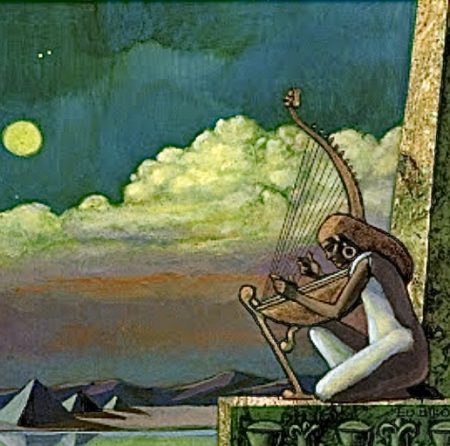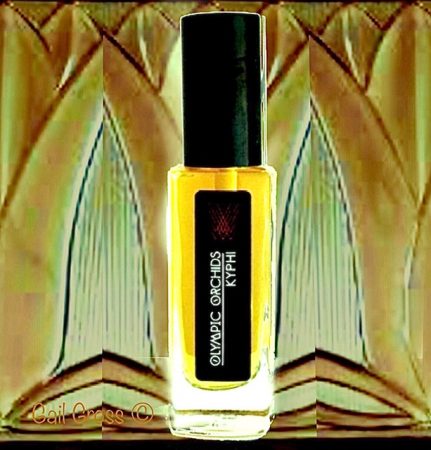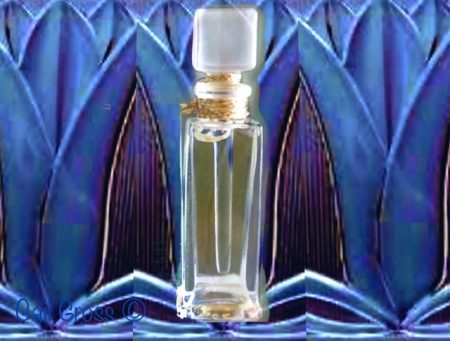
Frieze of Nefertiti making an offering. Egypt, ca. 1350 B.C.E. From the collection of the Brooklyn Museum of Art.
Ever since Napoleon’s invasion of Egypt in the late 18th century, a succession of explorers, artists and scientists have labored to discover, document (and sadly plunder) the wonders of ancient Egypt. The incredible treasures that Egyptologists and art historians have uncovered over these many years have inspired several waves of “Egyptian Revivalism” in Europe and the Americas.

Illustration by Leo and Diane Dillon from the children’s book Aida by Leontyne Price © 1990.
Fine and decorative art, music, architecture, jewelry, furniture design – and yes even perfume (Guerlain Djedi comes immediately to mind) – have been inspired and influenced by the style, symmetry and romance of ancient Egypt. The resulting artistic movement is known as “Egyptomania”. From obelisks, to the exotic operatic fantasies of Verdi’s Aida, through lotus blossom and reed designs of Louis Comfort Tiffany, public imagination has been, and continues to be, captured by all things Egyptian. The discovery of Tutankhamun’s tomb in the 1920s infused the Art Deco movement with Egyptian dominated motifs.

Egyptian women spraying perfume -wikipedia detail
Fascination with the fragrances of ancient Egypt in the artisan community has not been about “Egyptomania” as in the past but how each perfumer explores the raw materials and themes of that time, reimagining and reinterpreting the art of perfume. Recently our colleague, friend and former CaFleureBon Sr. Contributor Marianne Butler explored the influence of Egypt on olfactory art via a series of personal interviews with some of our favorite perfumers and creative directors. Here, in the context of CaFleureBon’s “Perfumer’s Workshop”, I offer the redacted responses to a single question by Marianne that I feel best point to the influence of ancient Egypt on six modern fragrances. In the interest of space I had to leave out many fascinating responses and a lot of well-researched information. I offer, by way of apology, my editor’s lament, borrowed from middle eastern mystic Baba Tahir: “When over the garden wall the branches hang, the garden’s keeper suffers every bitter grief. They must be cut back, even to the roots, though pearls and rubies be their fruits.” – Senior Editor, Gail Gross
The question asked of all six perfumers: “Are there certain notes/accords in this perfume that you think most refer to Ancient Egypt?”

Charenton Macerations Eye, Hatsheptsut. Bottle photo courtesy of Charenton Macerations ©. Bottle Photo representing Pharaoh’s Passion via St. Clair Scents ©.
Charenton Macerations’ creative director Douglas Bender talks about Eye, Hatshepsut, created in collaboration with perfumer Cecile Hua of Mane USA: “Eye, Hatshepsut is an olfactive homage to one of history’s most notable gender rebels: Pharaoh Hatshepsut of Egypt…The real key to understanding Eye, Hatshepsut olfactively is in its use of absence. The fragrance was formulated using many materials known to be anosmic to the average nose (salicylates, musks, ambers…). The scent is deceptively simple, but in reality, quite complex to unpack. This intentional use of the “unsmellable” was done as an homage to mummification and historical recreation. When we discover mummies or uncover long lost ruins, we try to recreate the world in which these things existed. However, our picture of that world is always imperfect. It is filled with gaps, unknowns… the elements lost to the passage of time. Instead of certainty, we are left to fill in these gaps as best we can, based on what we can surmise from any and all surrounding artifacts. Similarly, through the use of absence, Eye, Hatshepsut offers a different story to every nose that smells it. While you may not be able to smell every material in the bottle, your nose can craft its own distinctive interpretation of the composition by smoothing the gaps left by these absences…”
Diane St. Clair for St. Clair Scents Pharaoh’s Passion: “In 2019, archaeologists uncovered what they believe was an ancient perfume factory. Caked resins and spices were found in its jars. This is our interpretation of the last pharaoh’s passion…The legends surrounding Cleopatra—that she made love on beds of rose petals, that she perfumed the sails hanging from the cedar masts of her boats, and so on, combined with the findings of the possible fragrance factory, made me think that it would be fun to interpret what a perfume she would wear might smell like. When making the perfume, I called upon the stories about her love of roses, as well as archaeologists thinking that ancient perfumes might have been heavily reliant upon resins and spices for their aromas. I liked the idea of placing this very rich rose in a base of dark resins (labdanum, benzoin, dark vetiver, frankincense, rich cedar) but then counter balancing this with a fresh, spicy top, like something blowing in on the winds of her sails. I think what makes this scent unique is the balance between rich and dark, yet with a light, open top.”

Olympic Orchids Kyphi with an “Egyptian Revival” background pattern generated from an early 1920s Richard Hudnut rouge compact case. Photo by Gail Gross ©
Ellen Covey for Olympic Orchids Perfumes Kyphi: “Based on the common themes that run throughout various ancient formulas for the Egyptian incense that was burned to welcome the night, this version of Kyphi is a 100% natural mix of resins, essential oils, and absolutes, a liquid version of the incense formula that can be worn as an uplifting and offbeat perfume and is especially well suited for meditation, yoga, or other activities that require concentration…If I had to name the one note that I think typifies Kyphi, it would be Acorus calamus, also known as sweet flag. It was definitely a component of the ancient Egyptian incense, and was also used by the Egyptians to flavor wine and for medicinal purposes. Some accounts say that it is an aphrodisiac, and others that it has psychoactive properties. In any case, it has a very characteristic aroma, and you can smell it prominently in my version of Kyphi. Some people have commented that Kyphi smells like a tomb, and my guess is that the calamus is a big component of what creates that dark, otherworldly image.”

Chatillon Lux Nefertiti bottle photo via Chatillon Lux ©. Miles Davis performing in London in 1967, the year his Nefertiti album was released. Photo © David Redfern. Papillon Artisan Perfumes Anubis bottle photo by Papillon Artisan Perfumes ©. Image of Anubis via Wikipedia ©
Sean Maher reveals Chatillon Lux Nefertiti: “In creating his seminal post-bop classic ‘Nefertiti’, Mile Davis was inspired by the Egyptian queen renowned for both her beauty, wisdom and disregard for orthodoxy. Queen Nefertiti was known to wear a perfume of honey and orchid leaf…” Sean the perfumer was inspired by “…anything with incense and throaty, animalic florals … due to the pomades that they [the Egyptians] would wear. The ‘jazz cigarette’ accord was a fun one. I found a certified THC-free cannabis essential oil and combined with some dark patchouli. The oud also helped with this. Then to finish it, I researched strains of marijuana that showed creativity as one of their top effects, researched their terpenic content, and then created a terpenic accord to mimic the type of smell that those strains would have. It really meshed well with the bright green of the orchid leaf accord.”
Liz Moores talks to us about Papillon Artisan Perfumes Anubis: “With a name inspired by the Egyptian God of the afterlife, Anubis embodies the sacred mysteries of Ancient Egypt…Smoke and incense are two accords that instantly make me think of the Ancient Egyptians. There was not a ceremony or rite that was performed without the use of burning incense and when I came to create my first perfume Anubis, I knew that these notes would be my starting point. The idea of creating a fragrance as an homage to my favourite god was always subconsciously there but the idea did not take flight until I actively started work on Anubis. I knew that what I wanted to create had to feel dark and sacred, with a mystical element that would envelop the perfume. The use of pink lotus, frankincense and Egyptian jasmine firmly anchored Anubis to its origins, while the sweet, smoky notes give the illusion of a mystical incense burning on a censer.”

DSH Perfumes 1,000 Lilies (aka Susinon), the 5-ml. antique perfume. Background pattern generated from an early 1920s Richard Hudnut rouge compact case. Photo by Gail Gross ©
Dawn Spencer Hurwitz describes DSH Perfumes 1,000 Lilies (aka Susinon) from the Secrets of Egypt Collection. The Secrets of Egypt Collection was designed in conjunction with a ‘conversation lecture’ entitled “Ancient Aromatics” given by Dawn at the Denver Art Museum in September, 2010 as part of the museum’s exhibit KING TUT. To create these perfumes, Dawn Spencer Hurwitz researched, re-created and re-formulated sacred temple perfumes as well as luxury perfumes from the ancient world. “Susinon was a luxurious and strongly scented lily perfume that was made by the Egyptians as well as the Greeks, but the Egyptian version was thought to ‘excel most’. This fabulous fragrance was also used by Cleopatra to scent the sails of her royal barge, perfuming the air along the Nile as she sailed, proclaiming herself as Goddess and Queen. The exhaustive recipe for Susinon calls for spices and resins to first be soaked in fragrant wine and balanos oil [an oil expressed from the kernels of the Egyptian tree Balabites aegyptiaca] … When the oil is ready, it is added to the spices along with 1,000 lilies.”
I would like to thank Marianne Butler for the lion’s share of information included in this article and the perfumers for sharing their process, knowledge and perspective on ancient Egypt, its culture and perfume.
Gail Gross, Senior Editor
Thanks to the generosity of Dawn Spencer Hurwitz we have a draw for DSH Perfumes 1,000 Lilies Susinon for a 10 ml edp or vdp anywhere in the world
Thanks to the generosity of Ellen Covey of Olympic Orchids we have a draw for 30 ml of Kyphi USA ONLY or 5 ml anywhere else in the world
To be eligible for the above you must be a registered reader. Remember to click here or your comment won’t count. Tell us what you learned about the different approaches and how each perfumer was influenced by Egyptian raw materials or themes, if you have tried any of the fragrances in this article, where you live and which of the two Egypt inspired fragrances offered above you would like to win… your choice of Kyphi or 1,000 Lilies Susinon. Draw closes 10/5/2020
You can follow us on Instgram @cafleurebon @azarsmith7 @cm_fragrance @stclairscents @olympic_orchids_perfume @chatillonlux @papillon_artisan_perfumes @dshperfumes @spritzi_mcguillacutty
This is our Privacy and Draw Rules Policy
We announce the winners only on site and on our Facebook page, so like CaFleureBon and use our BLOG FEED…or your dream prize will be just spilled perfume.
